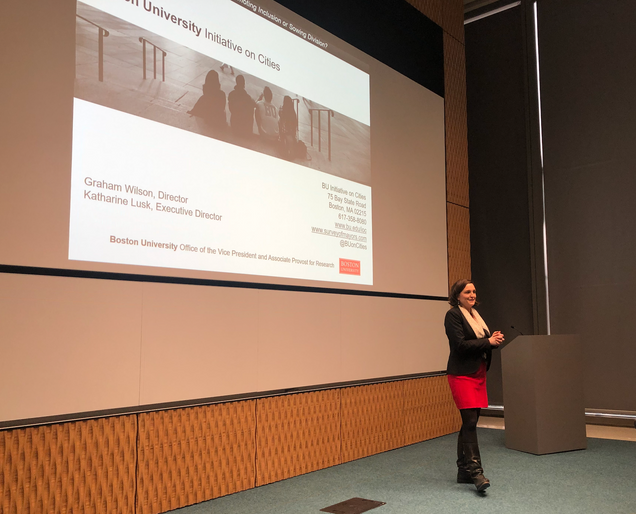By Doruntina Zeneli
 On Wednesday, February 27, professors from various academic fields of political science, global health, economics, and social work presented their findings on current issues surrounding the “American City” and unpacked the question of its impact on inclusivity and division.
On Wednesday, February 27, professors from various academic fields of political science, global health, economics, and social work presented their findings on current issues surrounding the “American City” and unpacked the question of its impact on inclusivity and division.
Research presentations focused on topics ranging from housing wealth effects, aged homelessness, and the relationship between machine learning and urban health.
Assistant Professor of Political Science, David Glick, explored how well the current housing stock fits the needs of residents in urban cities. He emphasized that mayors wanted to provide changes in housing availability and affordability to their constituents. The types of new housing that was considered ideal to mayors was single-family housing. Over 30% of mayors preferred this type of housing, but there was a considerable push for multi-family housing as well. Glick also mentioned that mayors wanted a modest 0 to 10 percent increase in the number of housing units made available to residents.
Similarly, Maxwell Palmer, Assistant Professor of Political Science, elaborated on the current housing crisis by emphasizing on the point of why it is so difficult to build new housing. He stressed that this is a crisis for middle-class home buyers. Housing shortages, zoning regulations, and the unrepresentative participation of different ethnic groups at local housing meetings were attributable factors to this developing crisis. Palmer highlighted that an overwhelming majority of White voters outnumbered Black, Hispanic and Asian voters at these meetings. Due to this misrepresentation, it prevented new housing projects from being implemented in local communities.
Katherine Einstein, Assistant Professor of Political Science, focused on the willingness of mayors to address racial discrimination in their cities. Einstein asked the question to mayors of how much discrimination residents face in their cities. A majority of majors agreed that “some” to “a lot” of discrimination is prevalent among Muslims, Immigrants and Blacks. Mayors also responded to the equal distribution of public services provided to its residents, which included parks, transportation and education. About 80% of mayors believed the quality of these services were equal among all ethnicities, while public education was slightly less equitable amongst these groups. Einstein also mentioned that mayors attitudes on these issues pose as an obstacle in forming future policies and solutions.
The emerging technology of machine learning is beginning to transform current industries as explained by Elaine Nsoesie, Assistant Professor at the School of Public Health. She showcased how public health improvements could be made through the use of Twitter data. By building data analytical models, artificial intelligence can identify key words in people’s tweets associated with food poisoning. As a result, AI is able to monitor reports of foodborne illnesses in cities and make more targeted restaurant inspections, which can ultimately prevent future outbreaks.
Several other professors such as Adam Guren, an Economics professor, expanded on issues concerning the housing wealth crisis and how the effects of the Great Recession persist today. Tom Byrne, Assistant Professor of Social Work, explored the issue of aged homelessness and its anticipated growth amongst adult males aged 46 – 54. On the other hand, Shea Cronin, Assistant Professor of Applied Sciences introduced state law firearm effectiveness and how every state wants to reduce gun violence, but current state policy decisions continue to impact race-specific and urban homicide rates.
Throughout these presentations, professors and researchers leveraged data to generate innovative solutions that could be implemented to solve prevalent urban issues in cities. From the rise in homelessness to prominent efforts to improve public health, for mayors and cities to make significant impact, they must consider altering current policies and programs in order to advance inclusion and reduce division.
View the presentation